What is LASER Treatment?
LASER TREATMENT (GERMAN TREATMENT)
The laser system has been introduced which is more precise and comfortable to work in ano-rectal condition i.e piles,fissure,fistula and pilonidal sinus.
The laser beam causes tissue shrinkage and degeneration at different depths depending on the laser power and duration of laser light application.
We can say it is nothing but advanced version of AGNIKARMA introduced by SUSHRUTA, father of surgery.
We have a unique method of treatment, named KSHARSUTRA, now famous worldwide, for all kinds of ANO RECTAL DISEASES.
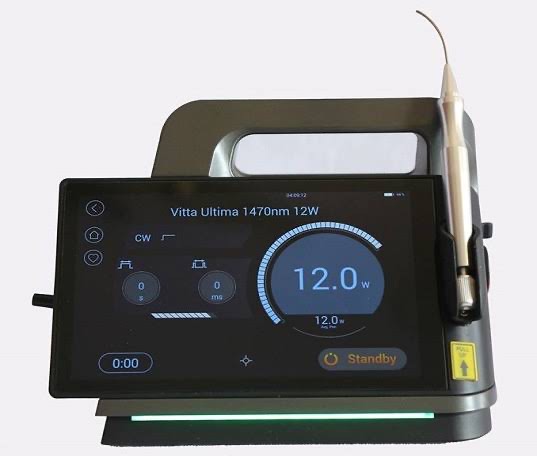
What is KSHARSUTRA Treatment?
KSHARSUTRA is a medicated seton having coatings of Ayurvedic herbs such as Snuhi Ksheer (Euphorbia Nerefolia), Apamarga Kshar (Acharanthus Asparagus) and Haridra (Curcuma Longa). Ksharsutra had excellent results in High anal fistulas, Horse shoe fistulas, Prolapsed Hemorrhoids, Chronic Fissures, Pilonidal sinus.
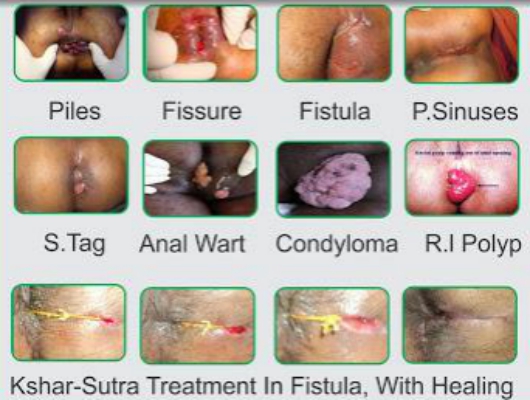
Advantages of KSHARSUTRA & LASER Treatment
- NO HOSPITAL STAY: Today every patient coming to us asking a first and foremost question, “When I can join my office or work after the procedure?”. It is our Day Care Centre, no need of any hospital stay. Patient can be discharged on same day and can join his work in next 3 days only, depending on the severity.
- MINIMAL PAIN: This is the main advantage of KSHARSUTRA treatment that after the procedure minimum pain is there compared to other procedures. No need to worry about the post-operative pain.
- NO BLEEDING: Compared with other techniques KSHARSUTRA treatment has no bleeding or rarely minimum bleeding.
- NO RECURRENCE: This is the important factor in all ano rectal diseases especially in piles and fistula. Patients have very much fear of recurrence but we assured you about the treatment and our success rate is 98%.
- NO INCONTINENCE: As KSHARSUTRA TREATMENT doesn’t include any sphinctre loss or any injury to internal sphincters. So these is no chance of incontinence.
- AFFORDABLE: Compared to all other treatments for ano rectal diseases KSHARSUTRA TREATMENT is the most affordable one.
PILES / HEMORRHOIDS
Piles are nothing but dilated veins within anal canal formed by superior, middle or inferior rectal veins.
Clinical Features
- BLEEDING: First and earlier symptom of hemorrhoids. It is bright Red, Painless and occurs along with defaecation.
- PAIN: Pain is common in thrombosed hemorrhoids or in case of hemorrhoids with FISSURES in ANO
- PROLAPSE: Prolapse is later symptom mostly seen in 3rd or 4th degree of hemorrhoids
- MUCOUS DISCHARGE: Mucous Discharge is a symptom of prolapse hemorrhoids
- ANAEMIA: Anaemia happens in bleeding hemorrhoids due to persistent and profuse bleeding.
Factors causing hemorrhoids
- HEREDITARY: Often seen in members of the same family.
- ANATOMICAL FACTOR: Absence of valves in superior Hemorrhoidal veins.
- CONSTIPATION: Straining to expel constipated stool causes dilation of veins.
- DIET & LIFESTYLE: Low roughage, Western Diet, Oily/Spicy junk food, Fast Life style, irregular diet.
- POSTURE: Continuous sitting or standing posture.
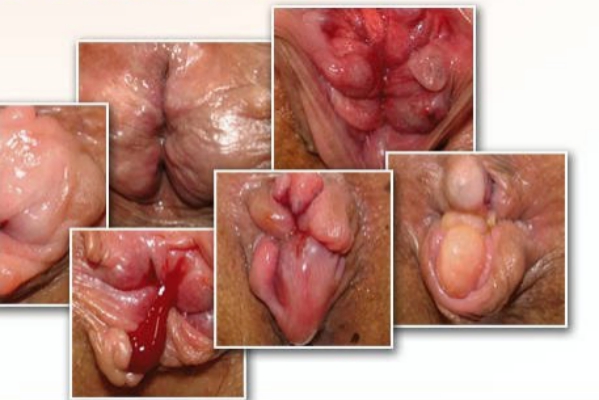
TYPES OF PILES / HEMORRHOIDS
PILES / HEMORRHOIDS are classified into following Categories based on Vascularity, Prolapse and Locations

ACCORDING TO LOCATION
- Internal Hemorrihoids: Remains within anal Canal and covered with Mucous Membrane. They are bright red and purple in colour.
- External Hemorrihoids: It forms at outside of anal orifice.
- Intero External Hemorrihoids: Both Internal or External Hemorrihoids are present.
- Thrombosed External Hemorrihoids: Sometimes blood in External Hemorrihoids forms a clot and thrombosis occurs. It may be very painful to patients.
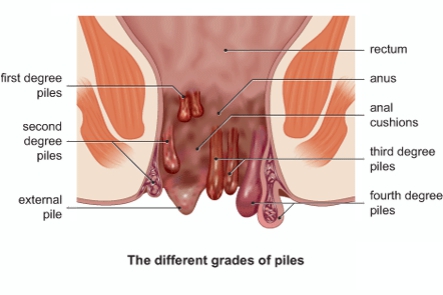
ACCORDING TO PROLAPSE
- 1st Degree: Doesn’t come out of anus.
- 2nd Degree: Coming out during defaecation and reduce spontaneously.
- 3rd Degree: Coming out during defaecation and need to replace manually.
- 4th Degree: Permanently prolapsed.

ACCORDING TO VASCULARITY
- Vascular Hemorrihoids: Bleeding is present. It is also called as Bleeding Hemorrihoids.
- Mucosal Hemorrihoids: No Bleeding. Mucous membranes slides downwards.
FISSURES
Tear of the skin of the lower half of the anal canal called as FISSURE. Spasm of the internal sphincter is always present. It may be anteriorly or posteriorly.
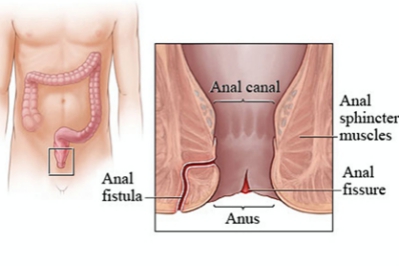
Clinical Features
- PAIN: First and foremost symptom of fissure. Pain starts with and after defaecation.
- BURNING: While paining patient may complain of burning sensation.
- BLEEDING: Streak of the blood comes along with defaecation. While in hemorrhoids you can see blood in the pan.
- PRURITUS ANI (ITHCING): May be present in some patients.
Type of Fissures
- ACUTE: Fissure with short history usually heals with conservative treatment.
- CHRONIC: Fissure with long history in which tear becomes deeper. Severe pain in this case may be present. Mostly need surgical treatment.
FISTULA
An anal fistula is an abnormal tract between anal canal and the skin. Anal fistula originate from the anal glands, which are located between the internal and external anal sphincter and drain into the anal canal. If the outlet of these glands becomes blocked, an abscess can form which can eventually point to the skin surface. The tract formed by this process is the fistula.
Clinical Features
- Recurrent anal abscesses.
- Pain and swelling around the anus.
- Pain with bowel movements.
- Bleeding.
- Bloody or foul smelling drainage (pus) from an opening around ahe anus.the pain may decrease after the fistula drains.
- Irritation of the skin around the anus due to persistent drainage.
- Fever, chills and general feeling of fatigue.
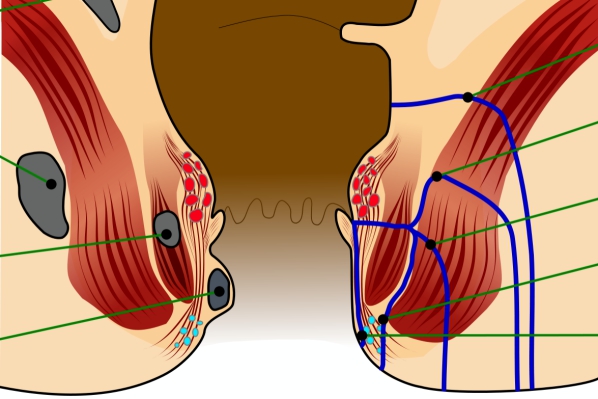
TYPES OF Fistula
FISTULAS are classified into following Categories based on Internal Openings and Sphincter Relation
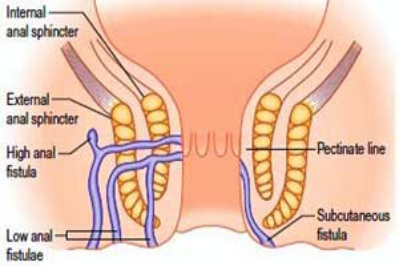
ACCORDING TO INTERNAL OPENING
- LOW LEVEL: Open below the Ano-Rectal Ring.
- HIGH LEVEL: Open at or above the Ano-Rectal Ring.
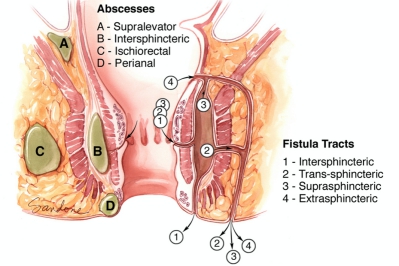
ACCORDING TO SPHINCTER RELATION
- SUBMUCOSAL
- INTER-SPHINCTERIC
- TRANS-SPHINCTERIC
- SUPRA-SPHINCTERIC
- EXTRA-SPHINCTERIC
PILONIDAL SINUS
A pilonidal sinus is a small cyst or abscess that occurs in the cleft at the top of the buttocks.it usually contains hair, dirt and debris. It can cause severe pain and can often become infected. If infected it may ooze pus and blood and have a foul odour.
Pilonidal sinus mostly affects men and is also common in young adults. It’s also more common in people who sit a lot, like cab drivers.
Activities that cause friction, like sitting, can force the hair growing in the area to burrow back under the skin. The body considers this hair foreign and launches an immune response against it, similar to how it would react when dealing with a splinter. This immune response forms the cyst around your hair.
Clinical Features
- Pain when sitting or standing.
- Swelling of the cyst.
- Reddened, sore skin around the area.
- Pus or blood draining from the abscess, causing a foul odour.
- Hair protruding from the lesion.
- Formation of more than one sinus tract or holes in the skin.
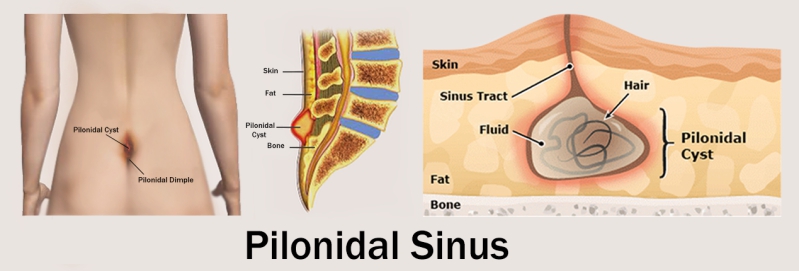
CHRONIC CONSTIPATION
Actually it’s not a separate disease but a symptom. But we mentioned it separately to know the importance of the key of all ano rectal diseases. That’s why we cannot neglect any type of constipation. According to W.H.O. survey 14% of the total population having chronic constipation.
Chronic constipation is difficulty in passage of stools that persists for several weeks or longer. Constipation involves straining during stool that resulted into hard stool which invites most of the ano rectal diseases.
We put chronic constipation into disease category to alert you about forthcoming diseases like piles, fissure or fistula.
